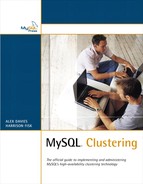Table of Contents
Introduction to Database Clustering
Hardware Considerations with MySQL Cluster
Networking Considerations with MySQL Cluster
Different Parts of a Cluster in MySQL Cluster
The MySQL Cluster Storage Engine
A Practical Example of Partitioning and Node Groups
Network Partitioning and Arbitration
A Brief History of MySQL Cluster
What’s New in MySQL Cluster 5.0
What’s New in MySQL Cluster 5.1
Determining the Number of Replicas
Determining the Amount of Disk Space
Before You Begin with MySQL Cluster
Obtaining and Installing MySQL Cluster
Installing MySQL Cluster from a Binary Tarball
Retrieving the Latest Snapshot from BitKeeper
Upgrading a BitKeeper Installation
Ensuring That MySQL Cluster Works
Configuring and Starting a Cluster
An Example of a config.ini File
An Example of a Working Cluster
Upgrading Through Major Versions
Other Methods of Starting a Cluster
Obtaining, Installing, and Configuring MySQL Cluster on Other Platforms
Using MySQL Cluster on 64-Bit Operating Systems
Calculating the DataMemory and IndexMemory Parameters
Common Errors While Importing Tables
ERROR 1114 (HY000) at line 227: The table ‘table_log’ is full
ERROR 1005 (HY000) at line x: Can’t create table ‘./ dbname/tablename.frm’ (errno: 4242)
ERROR 1005 (HY000) at line x: Can’t create table ‘./ dbname/tablename.frm’ (errno: 4335)
ERROR 1015 (HY000): Can’t lock file (errno: 4006)
ERROR 1050 (42S01): Table ‘ctest’ already exists
“Out of operation records in transaction coordinator”
Parameters to Define for All Management Nodes (NDB_MGMD_DEFAULT)
Parameters to Define for Each Management Node (NDB_MGMD)
An Example of a Management Section of a config.ini File
Parameters to Define for All Storage Nodes (NDBD_DEFAULT)
Controlling Timeouts, Intervals, and Disk Paging
Parameters to Define for Each Storage Node (NDBD)
An Example of a Storage Section of a config.ini File
Parameters to Define for All SQL Nodes (MYSQLD_DEFAULT)
Parameters to Define for Each SQL Node
Using Multiple Management Nodes
MySQL Cluster’s Native Backup Tool
Restoring a Backup by Using Native Hot Backup
Restoring a Backup Made Using mysqldump
The Management Console and Scripting
Doing a Rolling Cluster Restart
Issuing a SQL Command to Each SQL Node
Running MySQL in a Chrooted Environment
Using a Data Set That Is Not Representative
Using Inaccurate Data Access Patterns
Failing to Consider Cache Effects
Using Too Little Load or Too Few Users
The Query Cache in MySQL Cluster
Data Retrieval in MySQL Cluster
What to Look for When Something Goes Wrong
Arbitrator Decides to Shut Down a Node
DBTUP Could Not Allocate Memory
Multiple Storage Nodes per Server
Cluster Nodes Apparently Randomly Shut Down or Crash
Hardware Load Balancing Solutions
Software Load Balancing Solutions
Displaying the Status of the Cluster/Controlling Nodes
The <id> START, STOP, and RESTART Commands
The CLUSTERLOG ON and CLUSTERLOG OFF Commands
The CLUSTERLOG FILTER <severity> Command
The <id> CLUSTERLOG <category>=<threshold level> Command
The ENTER SINGLE USER MODE <sql-node-id> Command
The EXIT SINGLE USER MODE Command
The PURGE STALE SESSIONS Command
The ABORT BACKUP <backup id> Command
